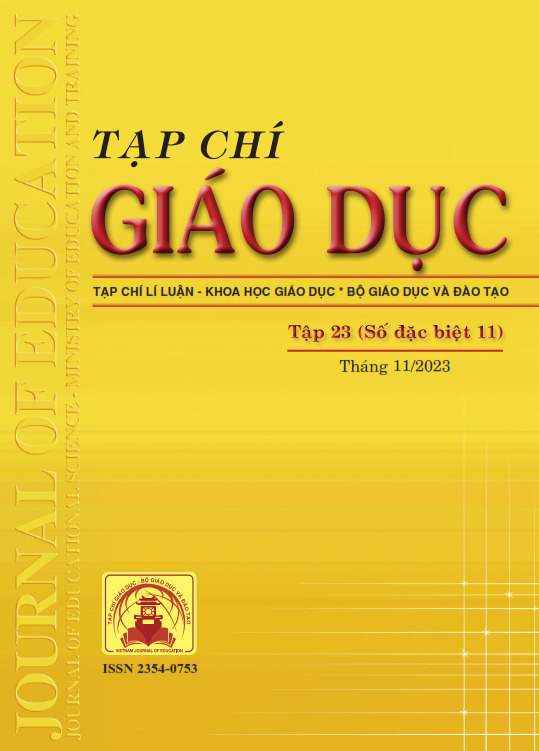Thiết kế và sử dụng học liệu điện tử dựa trên phong cách học tập theo mô hình VARK trong dạy học Lịch sử ở trường trung học phổ thông
Tóm tắt
From the school year 2022-2023, the 2018 Education Program is implemented at the high school level with the goal of developing students' competence and fostering quality. Among them, History, as one of the few “compulsory” subjects, has been and will be facing great challenges in terms of teaching method innovation. Meeting this goal requires that educational activities in general, and teaching activities in particular in History need to be designed and organized based on the needs and diversity of students' learning styles, apply information technology flexibly and creatively. The article emphasizes the viewpoint of applying the theory of VARK interactive learning method in the design of electronic learning materials in classroom teaching to develop the competence and qualities of students and outlines some measures to use electronic learning materials based on the VARK systematic learning method in classroom teaching in high schools. The design and use of electronic learning materials based on the VARK learning style in teaching history is expected as one of the “breakthrough” solutions for teaching innovation towards the development of student competence in the digital age.
Tài liệu tham khảo
Bộ GD-ĐT (2018a). Chương trình giáo dục phổ thông - Chương trình tổng thể (ban hành kèm theo Thông tư số 32/2018/TT-BGDĐT ngày 26/12/2018 của Bộ trưởng Bộ GD-ĐT).
Bộ GD-ĐT (2018b). Thông tư số 11/2018/TT-BGDĐT ngày 06/4/2018 ban hành tiêu chí để xác định hàng hoá chuyên dùng phục vụ trực tiếp cho giáo dục.
Cerbin, B. (2011). Helping first time practitioners engage in the scholarship of teaching and learning. SoTL Commons Conference. 40. https://digitalcommons.georgiasouthern.edu/sotlcommons/SoTL/2011/40
Chick, N. (2017). Learning styles. https://cft.vanderbilt.edu/guides-sub-pages/learning-styles-preferences/
Coffield, F., Moseley, D., Hall, E., & Ecclestone, K. (2004). Learning styles and pedagogy in post-16 learning. A systematic and critical review. London: Learning and Skills Research Centre.
Fleming, N. D. (2001). Teaching and Learning Styles: VARK Strategies. Neil Fleming, Christchurch.
Gestsdóttir, S. M., van Boxtel, C., & van Drie, J. (2018). Teaching historical thinking and reasoning: Construction of an observation instrument. British Educational Research Journal, 44(6), 960-981. https://doi.org/10.1002/berj.3471
López-García, A. (2023). Effectiveness of a teaching methodology based on the theory of historical thinking through active methods and digital resources in Spanish adolescents. Frontiers in Education, 8. https://doi.org/10.3389/feduc.2023.1175123
Mirza, M. A. & Khurshid, K. (2020). Impact of VARK learning model at tertiary level education. World Academy of Science, Engineering and Technology. International Journal of Educational and Pedagogical Sciences, 14(5), 354-361. https://publications.waset.org/10011198/impact-of-vark-learning-model-at-tertiary-level-education
Ninh Thị Hạnh (2019). Thiết kế và sử dụng học liệu điện tử trong dạy học Lịch sử ở lớp 10 ở trường trung học phổ thông. Luận án tiến sĩ Giáo dục học, Trường Đại học Sư phạm Hà Nội.
Retz, T. (2016). At the interface: Academic history, school history and the philosophy of history. Journal of Curriculum Studies, 48(4), 503-517. https://doi.org/10.1080/00220272.2015.1114151
Sánchez-García, J. M., & Toledo-Morales, P. (2017). Tecnologías convergentes para la enseñanza: Realidad Aumentada, BYOD, Flipped Classroom. Red: Revista de Educación a Distancia, 55(8), 1-15. https://doi.org/10.6018/red/55/8
Smart, A., & Jagannathan, S. (2018). Textbook policies in Asia: Development, publishing, printing, distribution, and future implications. Asian Development Bank.
Soininen, S. (2022). Teaching historical thinking in practice: a study of US history teachers’ views on using primary sources in AP and IB history lessons. History Education Research Journal, 19(1), 5. https://doi.org/10.14324/HERJ.19.1.05
Tanner, K. D. (2012). Promoting Student Metacognition. CBE-Life Sciences Education, 11(2), 113-120.
UNESCO (2023). Learning and teaching materials. https://learningportal.iiep.unesco.org/en/issue-briefs/improve-learning/learning-and-teaching-materials
van Drie, J., & van Boxtel, C. (2008). Historical reasoning: Towards a framework for analyzing students' reasoning about the past. Educational Psychology Review, 20(2), 87-110. https://doi.org/10.1007/s10648-007-9056-1
Wineburg, S. (2001). Historical Thinking and Other Unnatural Acts: Charting the Future of Teaching the Past (Critical Perspectives on The Past). Philadelphia, PA: Temple University Press.
Đã Xuất bản
Cách trích dẫn
Số
Chuyên mục
Giấy phép

Tác phẩm này được cấp phép theo Ghi nhận tác giả của Creative Commons Giấy phép quốc tế 4.0 .












